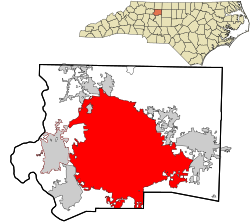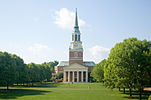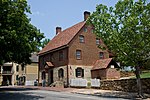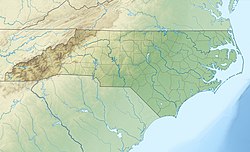
Winston-Salem, North Carolina
City in North Carolina, United States / From Wikipedia, the free encyclopedia
Dear Wikiwand AI, let's keep it short by simply answering these key questions:
Can you list the top facts and stats about Winston-Salem, North Carolina?
Summarize this article for a 10 year old
Winston-Salem is a city in and the county seat of Forsyth County, North Carolina, United States.[6] At the 2020 census, the population was 249,545, making it the fifth-most populous city in North Carolina, and the 90th-most populous city in the United States.[7] The population of the Winston-Salem metropolitan area was estimated to be 695,630 in 2023.[5] It is the second-most populous city in North Carolina's Piedmont Triad region, home to about 1.7 million residents.
Winston-Salem | |
|---|---|
| Nickname(s): The Twin City, Winston, W-S, The Dash City, The 336, Camel City | |
| Motto(s): | |
 Location in Forsyth County and North Carolina | |
| Coordinates: 36°06′10″N 80°15′39″W | |
| Country | United States |
| State | North Carolina |
| County | Forsyth |
| Founded | 1766 (Salem), 1849 (Winston) |
| Consolidated | 1913 (Winston-Salem) |
| Named for | Joseph Winston and "Shalom" (Hebrew meaning "Peace", after the Canaanite city mentioned in the Book of Genesis) |
| Government | |
| • Mayor | Allen Joines (D)[1] |
| • Interim City Manager | Johnnie Taylor[2] |
| Area | |
| • Total | 134.74 sq mi (348.98 km2) |
| • Land | 133.53 sq mi (345.84 km2) |
| • Water | 1.21 sq mi (3.14 km2) 0.90% |
| Elevation | 791 ft (241 m) |
| Population (2020) | |
| • Total | 249,545 |
| • Estimate (2022) | 251,350 |
| • Rank | 5th in North Carolina 89th in United States |
| • Density | 1,868.82/sq mi (721.55/km2) |
| • Urban | 420,924 (US: 98th) |
| • Urban density | 1,354.4/sq mi (522.9/km2) |
| • Metro | 695,630 (US: 86th) |
| Demonym | Winston-Salemite |
| Time zone | UTC−5 (Eastern) |
| • Summer (DST) | UTC−4 (EDT) |
| ZIP codes | 27023, 27040, 27045, 27101-27110, 27113-27117, 27120, 27127, 27130, 27150, 27152, 27155, 27157, 27198-27199, 27284 |
| Area codes | 336, 743 |
| FIPS code | 37-75000 |
| GNIS ID | 2405771[4] |
| Website | www |
Winston-Salem is called the "Twin City" for its dual heritage, and the "Camel City" as a reference to the city's historic involvement in the tobacco industry related to locally based R. J. Reynolds' Camel cigarettes. Many natives of the city and North Carolina refer to the city as "Winston" in informal speech. Winston-Salem is also home to six colleges and institutions, most notably Wake Forest University, Winston-Salem State University, and the University of North Carolina School of the Arts.









